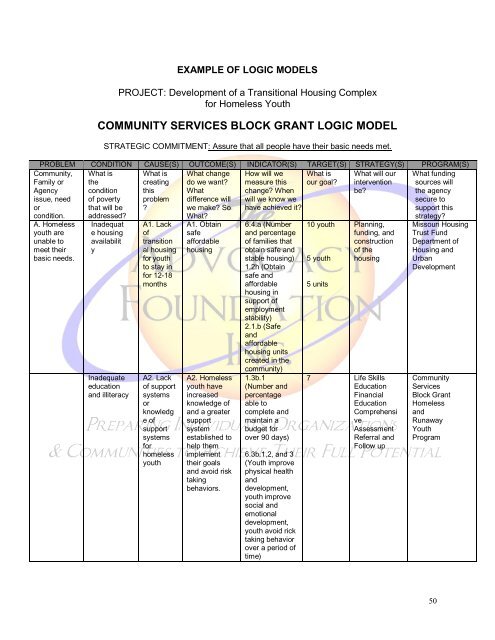Community Needs Assessment Process
Community Needs Assessment Process
Community Needs Assessment Process
Create successful ePaper yourself
Turn your PDF publications into a flip-book with our unique Google optimized e-Paper software.
EXAMPLE OF LOGIC MODELS<br />
PROJECT: Development of a Transitional Housing Complex<br />
for Homeless Youth<br />
COMMUNITY SERVICES BLOCK GRANT LOGIC MODEL<br />
STRATEGIC COMMITMENT: Assure that all people have their basic needs met.<br />
PROBLEM CONDITION CAUSE(S) OUTCOME(S) INDICATOR(S) TARGET(S) STRATEGY(S) PROGRAM(S)<br />
<strong>Community</strong>,<br />
Family or<br />
Agency<br />
issue, need<br />
or<br />
condition.<br />
What is<br />
the<br />
condition<br />
of poverty<br />
that will be<br />
addressed?<br />
What is<br />
creating<br />
this<br />
problem<br />
?<br />
What change<br />
do we want?<br />
What<br />
difference will<br />
we make? So<br />
What?<br />
How will we<br />
measure this<br />
change? When<br />
will we know we<br />
have achieved it?<br />
What is<br />
our goal?<br />
What will our<br />
intervention<br />
be?<br />
What funding<br />
sources will<br />
the agency<br />
secure to<br />
support this<br />
strategy?<br />
A. Homeless<br />
youth are<br />
unable to<br />
meet their<br />
basic needs.<br />
Inadequat<br />
e housing<br />
availabilit<br />
y<br />
Inadequate<br />
education<br />
and illiteracy<br />
A1. Lack<br />
of<br />
transition<br />
al housing<br />
for youth<br />
to stay in<br />
for 12-18<br />
months<br />
A2. Lack<br />
of support<br />
systems<br />
or<br />
knowledg<br />
e of<br />
support<br />
systems<br />
for<br />
homeless<br />
youth<br />
A1. Obtain<br />
safe<br />
affordable<br />
housing<br />
A2. Homeless<br />
youth have<br />
increased<br />
knowledge of<br />
and a greater<br />
support<br />
system<br />
established to<br />
help them<br />
implement<br />
their goals<br />
and avoid risk<br />
taking<br />
behaviors.<br />
6.4.a (Number<br />
and percentage<br />
of families that<br />
obtain safe and<br />
stable housing)<br />
1.2h (Obtain<br />
safe and<br />
affordable<br />
housing in<br />
support of<br />
employment<br />
stability)<br />
2.1.b (Safe<br />
and<br />
affordable<br />
housing units<br />
created in the<br />
community)<br />
1.3b.1<br />
(Number and<br />
percentage<br />
able to<br />
complete and<br />
maintain a<br />
budget for<br />
over 90 days)<br />
6.3b.1,2, and 3<br />
(Youth improve<br />
physical health<br />
and<br />
development,<br />
youth improve<br />
social and<br />
emotional<br />
development,<br />
youth avoid rick<br />
taking behavior<br />
over a period of<br />
time)<br />
10 youth<br />
5 youth<br />
5 units<br />
Planning,<br />
funding, and<br />
construction<br />
of the<br />
housing<br />
7 Life Skills<br />
Education<br />
Financial<br />
Education<br />
Comprehensi<br />
ve<br />
<strong>Assessment</strong><br />
Referral and<br />
Follow up<br />
Missouri Housing<br />
Trust Fund<br />
Department of<br />
Housing and<br />
Urban<br />
Development<br />
<strong>Community</strong><br />
Services<br />
Block Grant<br />
Homeless<br />
and<br />
Runaway<br />
Youth<br />
Program<br />
50

















